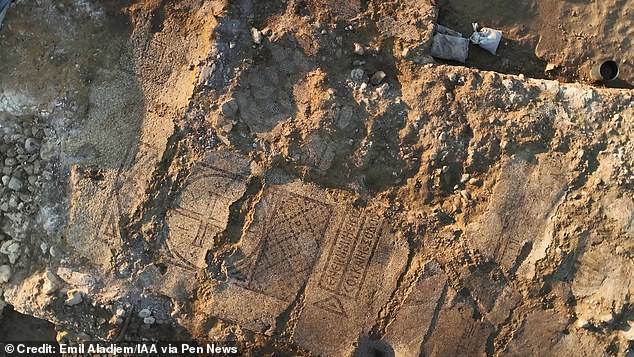Archaeologists have discovered a 1,500-year-old monastery with an intricate mosaic floor that bears a Bible verse blessing all who read it.
‘Blessed are you when you come in and blessed are you when you go out,’ reads the verse inscribed in ancient Greek that sits at the center of the intricately designed floor.
The discovery was made near the Israeli city of Kiryat Gat, the Israel Antiquities Authority (IAA) announced Monday, who described it as one of the largest and most significant sites uncovered in the area from the time period.
The monastery dates back to the fifth through sixth centuries CE, which was during the rule of the Byzantine empire, also known as the Eastern Roman Empire.
Those years saw the spread of Christianity and the construction of significant religious sites such as the Church of the Holy Sepulchre in Jerusalem.
The newly discovered monastery is located in an ancient settlement established during the preceding Roman period, but persisted for approximately 600 years until the end of the Byzantine period.
‘This is the largest and most significant Roman and Byzantine period site uncovered in this area,’ said excavation leaders Shira Lifshitz and Maayan Margulis.
The dig also uncovered remains of at least ten buildings, a winepress and a large warehouse building.

‘Blessed are you when you come in and blessed are you when you go out’ (Deuteronomy 28:6), reads the verse inscribed in ancient Greek in the center of the intricately designed floor.

The ‘blessing’ was one a floor for an ancient building
But the monastery is especially significant because its mosaic floor is a first-of-its-kind discovery.
‘The mosaic discovered in Kiryat Gat is one of the most unique ever found in Israel,’ Mark Avrahami, head of artistic conservation at the IAA, said in the statement.
What makes this mosaic so unusual is the incorporation of very small stones into its geometric pattern, which served to highlight the cross-shaped decorations, according to the researchers.
In addition to the Bible verse, the floor features crosses, lions, doves, an amphora (a ceramic maritime shipping jug), flowers and geometric patterns.
‘Transferring mosaics is a complex process that requires great skill and precision,’ Avrahami said, but the floor will soon be moved to the IAA’s mosaic workshop for preservation before being put on public display in the city of Kiryat Gat.
The dig also unearthed a ‘great quantity’ of artifacts from the monastery and the surrounding site, including imported wares, coins, marble elements, and metal and glass vessels, ‘all attesting to the rich and significant community living here,’ researchers shared.
The settlement is situated on a central road junction connecting the mountain region to the coastal plain, and apparently served the area’s smaller settlements as well as travelers passing by.
‘The findings indicate a succession of settlement starting from the early Roman period (1st century CE) and through until the end of the Byzantine period (end of the 6th century CE),’ the team said.

Researchers said the mosaic is one of the most unique of its kind found in the region

What makes this mosaic so unusual is the incorporation of very small stones into its geometric pattern, which served to highlight the cross-shaped decorations, according to the researchers

The settlement is situated on a central road junction connecting the mountain region to the coastal plain, and apparently served the area’s smaller settlements and travelers passing by
The Byzantine Empire reigned from 330 to 1453 CE. Its rule began when the Emperor Constantine split the Roman Empire into a western and eastern half.
The eastern half remained the dominant power in ancient Europe throughout the rest of late antiquity and even during parts of the middle ages, eventually coming to be known as the Byzantine Empire.
Its capital, Constantinople, was conquered by the Ottoman Turks in 1453, thus marking the end of the Empire’s more than 1,000-year reign.
While the recently excavated settlement was still active during the Byzantine period, it expanded significantly, the researchers concluded.
This growth included the construction of the monastery and the winepress.

The researchers also uncovered a ‘very sophisticated’ winepress, which made wine that was sent throughout the country and to the other side of the Mediterranean Sea

Like the monastery, the winepress also features mosaic flooring in the fermentation rooms and the collecting vat, made of blue and white stones

The researchers also uncovered numerous artifacts from the site, including ‘good quality toys that show status’
Like the monastery, the winepress also features mosaic flooring in the fermentation rooms and the collecting vat, made of blue and white stones.
The researchers described this winepress as ‘very sophisticated,’ adding that its construction and development likely involved ‘significant financial resources, time and a range of professional work and effort.’
It produced wine that was sent both throughout the country and to the other side of the Mediterranean Sea, they said.
The dig also uncovered ample evidence of local pottery production, such as detritus left behind by a ceramic factory, garbage pits, discarded vessels that were misshaped during production, and even a number of vessels that are ‘unique to this site.’
‘The discovery of the site highlights the historical richness of Kiryat Gat and its surroundings, shedding light on the centrality of the region in antiquity,’ said Svetlana Talis, Director of the Southern Region at the Israel Antiquities Authority.












